Blah Blah Blah New York In The Seventies
“This was the last period in American culture when the distinction between highbrow and lowbrow still pertained, when writers and painters and theater people still wanted to be (or were willing to be) ‘martyrs to art.’ This was the last moment when a novelist or poet might withdraw a book that had already been accepted for publication and continue to fiddle with it for the next two or three years. This was the last time when a New York poet was reluctant to introduce to his arty friends someone who was a Hollywood film director, for fear the movies would be considered too low-status.”
— I swear to God, forty years from now someone who is currently in her 20s will be crafting a special Snapchat Review of Emoji visual essay about how the mid-teens in New York was the last time the listicle-makers still had their proper place as the age’s arbiters of cultural capital. Anyway, if you can stand to read one more thing about New York in the ’70s — an era now as distant from our own as World War II was from then — this Edmund White piece at least has the advantage of relative brevity to recommend it.
Pure Bathing Culture, "Palest Pearl"
Pure Bathing Culture’s “Pray For Rain” may be the best song I’ve heard all year. This… is not that, but if you can get past the lyrics you’ve got some very catchy synth-pop going on and sometimes that’s really all you need. Particularly, say, on a seasonable Friday with the weekend in your sights. Oh, what a coincidence: that’s where we are right now. Enjoy.
New York City, September 9, 2015
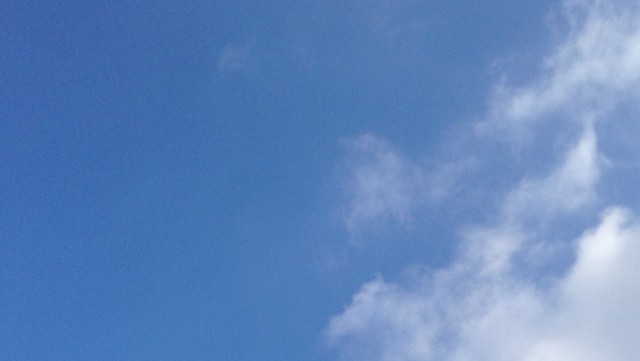
[No stars] Why, the three-year-old wanted to know, were the lights outside still on? The gloomy gathered clouds were doing the most they could, but didn’t have the numbers to sustain it, now and then letting through a little thinnish light. Regardless of the dimness, though, it was already hot on the long new walk to the pre-K, and the walk cutting back to Columbus Circle. The sun had found its way out, and the climate control on the subway train failed to take off the resulting layer of sweat. Water cascaded from air conditioners to the sidewalks, the overladen air dropping its burden at the first opportunity. A localized darkness covered Fifth Avenue in the afternoon. A few raindrops appeared on lumber on top of a scaffold; an umbrella went up. Nothing conclusive happened. The air conditioning at home was shut off, in advance of the announced mosquito spraying. Just past lights out, a rubbery smell seeped into the stuffy bedroom, where the covers had been kicked away. It strengthened for a while, and then either faded out or became olfactory background. Later, dreams under a tangled sheet were interrupted by wet-tire sounds from the avenue, the presumed pesticide treatment presumably being washed off by the rain.
Manhattan Real Estate Explained, In Just One Street
by Brendan O’Connor
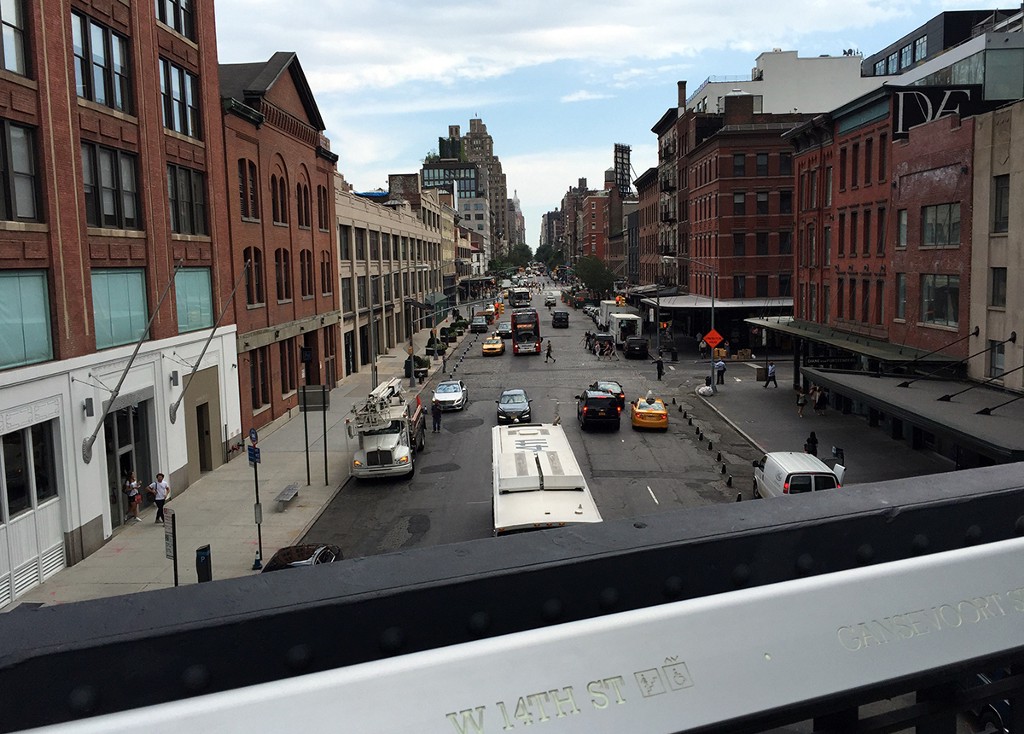
Manhattan’s 14th Street is never a pleasant place to be, but there are few streets that one can comfortably walk from end to end on a hot, late summer afternoon whereupon the full blossoming of capital is more radiantly displayed. There is an idea of New York, and especially of Manhattan, as a place where the wealthy and the less wealthy (and even the not-at-all wealthy!) live in close proximity, even adjacent, to each other, and that this arrangement produces ambition in the latter to attain what the former has, and some amount of respect for the humanity of the latter in the former. This is not just incidental to life here, the thinking goes, but integral to it: Everyone, or almost everyone, suffers the city together.
At least as far as most pedestrians are concerned, 14th Street’s westernmost terminus is the High Line, an elevated, linear park built on a disused, mile-and-a-half long section of the West Side Freight Line. There is a set of stairs up to the railroad track a few steps past an enormous Diane von Furstenberg store. Von Furstenberg, a high-end fashion designer, and her billionaire husband, Barry Diller, donated upwards of thirty-five million dollars towards the completion of the High Line. (Von Furstenberg and Diller have also pledged one hundred thirty million dollars to refurbish nearby Pier 54, in the Hudson River.)
The stretch of 14th Street between the High Line and 8th Avenue is heavily oriented towards retail, which is perhaps unsurprising, given that the High Line attracts at least five million visitors annually. (A smart investment on Von Furstenberg’s part, then!) But the High Line is a magnet for more than tourists’ money: According to a study conducted by the New York City Economic Development Corporation, before the park’s construction in 2003, the surrounding West Chelsea neighborhood — a mix of residential properties and light industrial businesses — were valued at eight percent below Manhattan’s overall median. In 2005, the city rezoned West Chelsea for luxury development, and, by 2011, residential property values appreciated beyond borough-wide values. “The park, which will eventually snake through more than twenty blocks, is destroying neighborhoods as it grows,” Jeremiah Moss wrote in the New York Times in 2012. “And it’s doing so by design. While the park began as a grass-roots endeavor — albeit a well-heeled one — it quickly became a tool for the Bloomberg administration’s creation of a new, upscale, corporatized stretch along the West Side.” Price per square foot for residential units within five minutes walking distance of the High Line more than doubled in less than a decade.
A random selection, from Streeteasy, of rental apartments in the High Line’s immediate area: a fourteen-thousand-dollar-a-month two-bedroom condo “on the cross road of Manhattan’s ultra stylish Meat Packing District, Chelsea and the West Village”; a thirty-three-hundred one-bedroom apartment with no broker fee; a twenty-seven-hundred-dollar-per-month one bedroom above Solstice Sunglasses. As one walks east along 14th Street, away from the High Line, out of the cobblestone and into the pavement, there are fewer high-end brands (DVF; Chanel; Fjallraven) and more shops whose wares seem more expensive than they should be, but not so expensive that you can’t not convince yourself that maybe they are somehow worth it: Kiehl’s, Patagonia, Levi’s. Also: Apple.
Eighth Avenue is the last stop on the L train, which rattles beneath 14th Street, intersecting with the A/C/E at Eighth Avenue, the F/M and 1/2/3 at Sixth Avenue, and the N/Q/R and 4/5/6 at Union Square. The Sixth Avenue subway station, which could really also be called the Seventh Avenue subway station, is matched only in its labyrinthine sprawl by the West Side Market just above. Between Eighth Avenue and Sixth Avenue is a hodgepodge of bars and bodegas; the Local 237 Teamsters union building sits across the street from a nail salon called “Yo Yo Spa.” Homeless folks sleep on the steps of the enormous Salvation Army executive headquarters. Rental apartments in the area are listed at essentially the same price range as a few blocks west: a three bedroom for twelve grand a month; a one bedroom for nearly thirty-eight hundred dollars; and a three-thousand-dollar one bedroom.
After Sixth Avenue, the buildings become taller and cleaner; there is more business attire. There are also students: Last year, construction was completed on the New School’s new University Center on Fifth Avenue, which, in the way of expanding college campuses, could have been terrible, but sort of isn’t, as these things go. (New York’s Justin Davidson praised the building for “balancing fresh needs with history” and retaining the New School’s “sensitive boldness.”) Still, the area does not feel like a campus, and caters more to its office workers. The average asking rent for Class A office space in the area reached eighty-three dollars per square foot this spring, the Villager reported in May. According to the Wall Street Journal, in 2011 the average asking rent in the immediate area was forty-six dollars per square foot. The rise has been driven largely by start-up and tech tenants like Yelp, which added ten-and-a-half thousand square feet to its Fifth Avenue headquarters last year. Also headquartered on Fifth Avenue is Compass, a “technology-driven real estate platform,” which last year began subletting office space (paying in the mid-sixties per square foot, the Real Deal reported).
Union Square is not 14th Street’s geographic center, but it is its center of gravity. On its worst days it is only slightly less chaotic than Times Square, thirty blocks north, but even then the chaos is more purposeful, or at least bounded: This is where the skaters and bikers are; this is where the street vendors selling African black soap are; this is where the Whole Foods shoppers skip past everyone else. In the mornings, the subway station below is a melee, but, as everyone knows where they are and where they need to be and how to get there, it is a navigable one. In the afternoons, there are often fewer people, but they are also less familiar with the space, and do not know how to get anywhere, disrupting the flow of bodies.
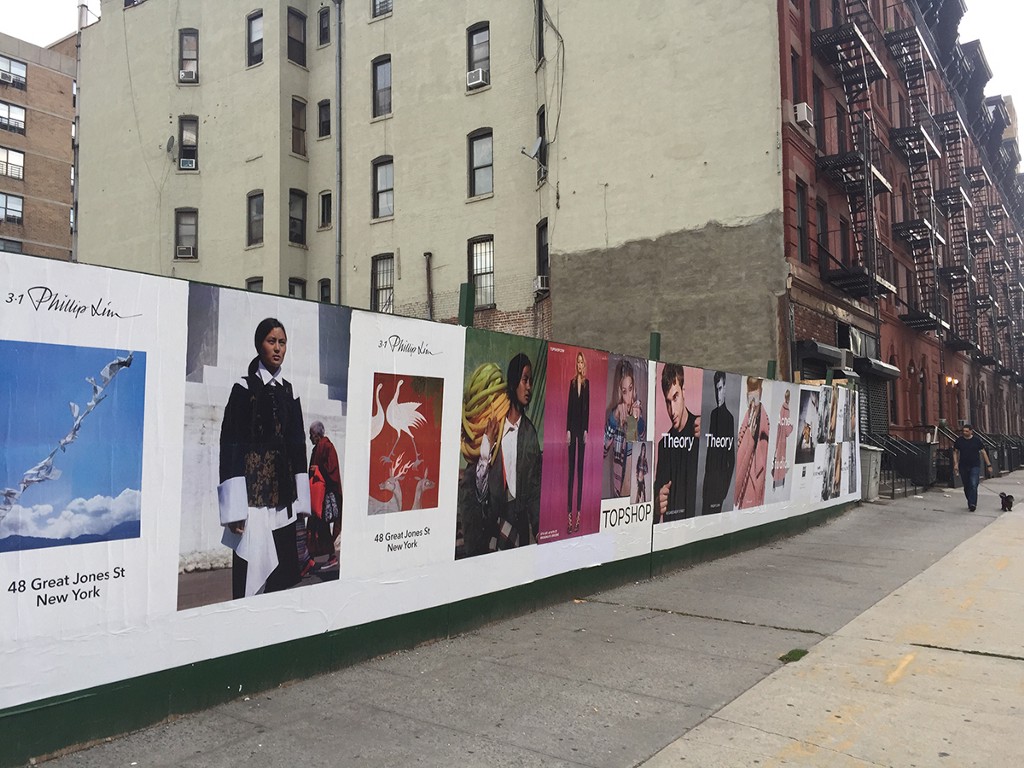
The blocks between Union Square and First Avenue are sort of a lost space — a friend once referred to the Third Avenue L station as “the most useless subway stop in New York.” (It and and the First Avenue station are the only two in Manhattan that do not intersect with a north-south subway line.) Here there are bars, hospitals, and more expensive apartments: fifty-five hundred for a two bedroom; five grand for a three bedroom; thirty-two fifty for a two bedroom. After First Avenue, there are three long blocks without a subway station, and then the street ends. To the north of these three blocks is the southern edge of Peter Cooper Village-Stuyvesant Town, an enormous planned community ushered into existence by Robert Moses, where, according to Streeteasy, the average asking rent for a one bedroom is more than thirty-five hundred dollars. To the south is Alphabet City, the easternmost section of the East Village, a now thoroughly-gentrified neighborhood — two new buildings, bizarrely, have been marketed under pop star’s names, The Robyn and The Adele — that is also home the city’s highest concentration of bars.)
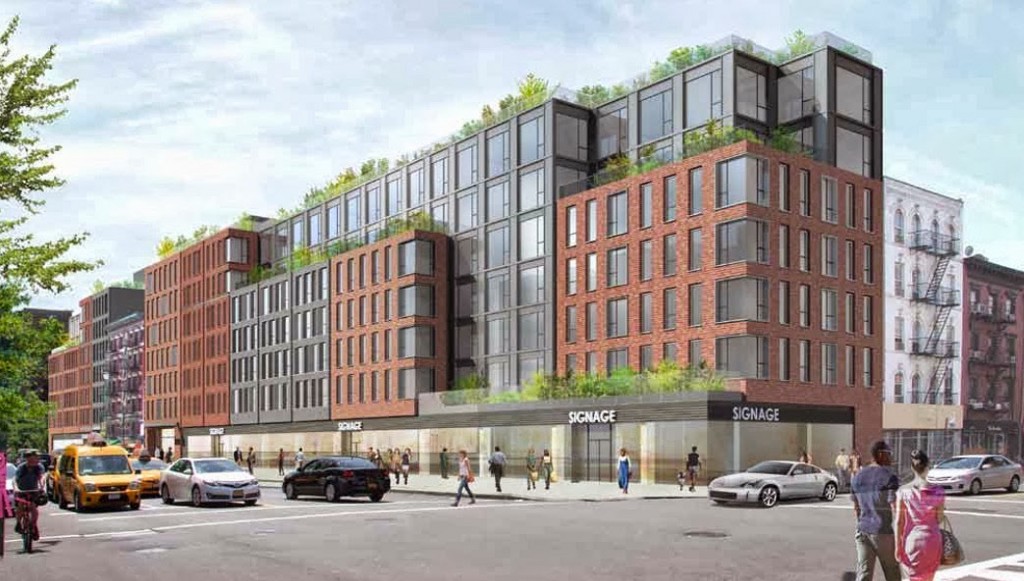
This stretch of 14th Street, after the last subway station and before, at the edge of the East river, the Consolidated Edison power plant, is usually quiet. “It feels a little slow-paced — it almost feels like Brooklyn in a way,” one developer working in the area, Steve Ferguson told the Journal, in February. It does not, at all, but what’s more Brooklyn than plopping a big luxury development into a slow-paced neighborhood? Indeed, a huge swath of land — eight parcels! — between Avenues A and B were bought up and is being redeveloped into an enormous luxury mixed-use behemoth, EV Grieve reported in 2013. (This is what it’s going to look like, apparently.) Construction is due to be completed in January 2017.
Meanwhile, even further east, on the corner of Avenue D, at 644 East 14th Street, just across the street from Con Ed, the city’s electric heart, an empty lot awaits construction. A mixed-use building permit application was filed last year and approved in January: the development will total almost sixty-two thousand square feet, with nearly eight thousand, six hundred square feet of commercial space on the ground floor. Signage on the green walls around the lot indicates that building was supposed to have been completed this summer, but, peering through the holes in the walls, the ground does not seem to have yet been broken, even as posters advertise retailers like Theory, Coach, and Acne Studios. As it happens, Coach threw a party on the High Line earlier this summer — attended, naturally, by Diane von Furstenberg. And so now we have the promise of a New York that no longer festoons its capitalist mythologies with promises of social mobility but rather a place where rich people can sell things to each other, and sometimes to slightly less rich people, without having to worry about too much else at all.
Rendering of forthcoming 14th Street development by RFK
The Awl Podcast: Uber

Welcome to THE UBER EPISODE. We’ve got Jonathan Shainin, editor of Long Reads at The Guardian, Jay Kang, a contributor to NYT Mag, and Matt Buchanan.
The questions: Is Uber the future of everything? Is public transit doomed? Will surge pricing spread… everywhere? Are we all destined to labor forever at the whims of app children??? OR: Is the anti-Uber movement just soft-left polite politics? Haha???
For background, read Matt’s piece on Uber’s “Endgame” and see Travis Kalanick’s response here.
How to listen:
Subscribe in iTunes
The podcast page
Soundcloud
The RSS feed
Or just search for The Awl in any popular podcast app.
Thanks, of course, to our sponsor, Williamsburg Pizza, which is offering a SPECIAL OFFER to Awl Podcast listeners: 70% off any single pie, for pickup, at the Williamsburg and Lower East Side locations.
Just tweet at @awl and @wburgpizza with the hashtag #gimmeawltheza and the name of the pie you want.
@Wburgpizza will respond with instructions, and then you’ll be eating delicious cheap pizza. HOPE YOU ENJOY.
The Year The Internet Ended
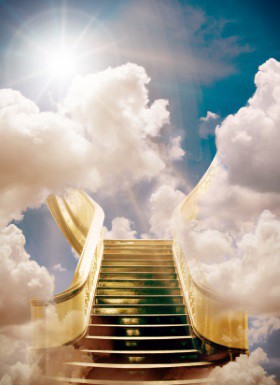
I spent most of my summer working on a novel, but I turned over the first third of it to my agent at the end of last week and just received a very disappointing response. The feeling is that it is “too fantastical,” that “no one would ever believe it,” that it is “the worst kind of wish-fulfillment outside of slashfic,” and that “all books are terrible but this is especially bad because it’s so over-the-top dreamy that no one could really accept the premise.” I heartily disagree and want to show the powers that be that there is in fact an audience that is hungry for this kind of material, so I am putting a brief excerpt here in hopes that you all will find it pleasing and demand more. All you really need to know about the story, which has the working title of The Year The Internet Ended, is that it opens with our protagonist, a brilliant blogger named Alan Falk — a handsome, sensitive, tortured soul who feels everything too deeply but is irresistible to the ladies — waking up from a seven-month coma that he fell into after being electrocuted by a surge suppressor. He is released from the hospital but finds himself in an unrecognizable world where no one speaks to him or anyone else. In this scene he wanders around New York City trying to understand what has happened.
He staggered up the street acutely aware that the only sound he heard as people passed by was that of his own labored breathing. The occasional siren in the distance was even more pronounced because of the strange, oppressive silence that surrounded everything. Birds chirped and the wind rustled through the trees, but no one spoke or even made eye contact as he wandered along. It was as if they were afraid to engage with each other and his pleas for help were met, if at all, with scolding stares.
Suddenly, out of the corner of his eye, he saw a finger signalling him on. In the doorway of a nondescript apartment building a beautiful woman about his age gestured him to follow her while seemingly looking around to make sure that no one else saw. He entered the lobby and she quickly pushed him into her ground-level dwelling. She bolted the door behind him and sat him down at a small table away from the window.
“You’re Alan Falk,” she said, her voice hushed.
“How… how did you know that?”
“I used to follow you on Twitter and Facebook. In the before time. I’ve been reading you ever since you had your blog I’ve Heard There Was A Secret Chord,” she smiled.
“That all seems so long ago,” he said. “But what… what happened? Why is everything so different now? So… quiet?”
And that was how he learned about the end of the Internet, about the strange electrical signal that came from space and shut down everything on the worldwide web and beyond, even, thank God, all the idiot apps, rendering browsers useless and smartphones elaborate and expensive instruments with which to make terrible sounding phone calls and take pictures of things you had to show other people in person if you wanted them to be seen.
“At first all the governments of the world banded together with private industry in a desperate attempt to bring everything back online but every effort failed. And then, as the weeks went on, we started to realize that life was much better without the Internet. Everyone became so much less angry. We solved climate change. Restaurants started to focus on how food tastes rather than if it would show well enough to be photographed and shared. The Kardashians stopped being a thing. All the VC scumbags on Sand Hill Road had to find new scams to pull, mostly involving pharmaceuticals. It’s almost like heaven on earth.”
“It sounds like some beautiful dream,” he said. “But why is everyone so quiet?”
“Well, that’s the Vow. It came from The Moment of Great Shame, when we all realized how fucking stupid and intolerable and just generally gross we were by always having opinions and sharing them as loudly as we could as soon as they popped into our idiot heads. Once there was no Internet on which we could be gigantic fucking loud morons shouting our imbecilic, poorly informed thoughts about things all the time, we were so embarrassed by what we’d done that we all promised to stay silent in public for a year.”
“Everyone agreed to this?” he asked incredulously.
“Well, not everyone. But the men — and it was mostly men — who refused to be quiet were sent to reeducation camp in North Dakota where they were sentenced to read every thinkpiece about Jonathan Franzen, and they all died of boredom and/or rage.”
“So no one speaks in public?”
“Or writes anything either,” she beamed. “We finally realized that there was already so much that has been said even in this century alone that adding more to the pile would be like smearing a six-foot layer of shit on top of a heaping, fetid landfill. The Vow keeps anyone from expressing themselves in any way, which is good because everyone’s so fucking stupid and full of all the most dumbass possible thoughts any human could have but was ashamed enough, before the Internet, to shut the fuck up about.”
“It sounds like everything is finally amazing,” he said, after thinking about it for a couple of minutes. He could already tell how much better this world was because of the fact that he had actually spent a couple of minutes thinking about something before saying anything about it. “But if no one talks or writes, what does everyone do for fulfillment?”
“We do sex to each other, S&M; bondage style!” she proclaimed, handing him a whip while stripping down to show an amazing but submissive sex body.
It gets a little graphic at this point, which I am ashamed to admit is purely for commercial purposes. But what do you think? I’m sure some of you literary types are all, “Alex, it seems incredible so far, but where is the conflict? You’ve set up an amazing utopia, what problems could there be?” Well, I have that covered! The problem is the Vow is about to expire and a bunch of stupid self-important types who feel like the world has missed out on their opinions are ready to unleash their streams of pompous windbaggery once more through the medium of the printed word, and our protagonists need to find a way to make sure everyone stays shut the fuck up. It’s full of drama, tension and subtle social commentary. There’s no way this wouldn’t be a best-seller, right? Register your support on social media or whatever and let’s make Big Publishing give me millions of dollars for this. Thank you.
Photo: Shutterstock.com
A Poem by Amit Majmudar
Apocalypse Shopping List
Lead-lined gonad-guards.
Lysol (radiation sickness causes killer runs).
Breadboxes, to bury stillbirths.
Flare guns, glue guns, gun guns.
Marijuana brownies for the burn units.
Ersatz shrouds (viz., bedsheets, towels, sails).
Triple-earwig-pincer Biohazard labels.
Fun Size Snickers Not Labeled for Individual Sale
But good to barter in a pinch.
Amputation pails.
Seeing-eye dogs bunker-kenneled in Kennebunkport, Maine,
To jog the flash-blind through uranium rain.
Astronaut ice cream for the bedbound.
Catheters (various calibers).
Lice combs to harvest protein.
Steri-strips.
Spike strips.
Benadryl, good for baby’s colic or mommy’s hives.
Teriyaki turkey jerky.
Paperback copies of Slaughterhouse-Five.
Bullhorns for the water rioters.
Firehoses for the riot police.
Wooden stakes, because you never know.
Four-ounce jars of Fleischmann’s yeast.
Gallon jugs of Zen.
Rabbit traps, for the mice of the future.
Bear traps, for the men.
Amit Majmudar’s most recent book of poems, Dothead, was published by Knopf. Godsong, his verse translation from Sanskrit of the Bhagavad Gita, is forthcoming in 2018.
The Poetry Section is edited by Mark Bibbins.
Writing Before Selling
“There’s always room for another story. There’s always room for another tune, right? Nobody can write too many tunes. So if you have stories to tell and can tell them competently, then somebody will want to hear it if you tell it well at all. To believe that there is somebody who wants to hear that story is the kind of confidence a writer has to have when they’re in the period of learning their craft and not selling stuff and not really knowing what they’re doing. It’s like being adolescent for years and years after your adolescence.” — Choire has a conversation with Ursula K. Le Guin.
Christopher Bissonnette, "Epoch"
I had a bunch of stuff this week that I had scheduled for Wednesday but what with the whole “Monday off” thing I thought yesterday was Tuesday so I totally skipped it all, and you know what? None of it matters! Who cares? So some stuff doesn’t get done! So some appointments get skipped! I’m sure that pain in my arm will go away on its own. Nothing means anything! Our lives are spent scrambling about for no reason while death waits for all of us and laughs at our paltry pursuits. Anything I could have done yesterday wouldn’t have made a difference either way. And it occurs to me that the exact same thing could be said about today. I might just take the rest of the week off! But before that there is a new Christopher Bissonnette track for all of us to enjoy, so enjoy.
New York City, September 8, 2015
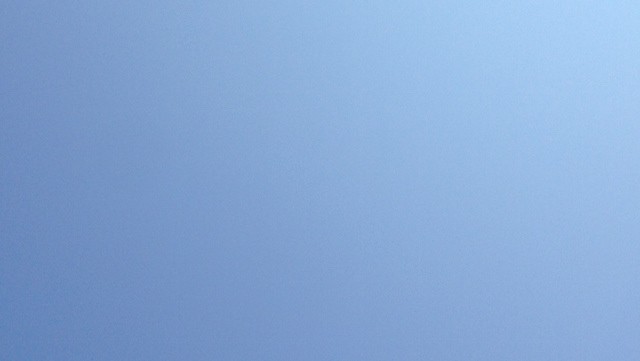
★ The heat hurt a little, out in the full sun. A FedEx truck pulled up to double-park outside the Apple Store, blocking the view of oncoming taxis on Broadway, so it took a sweaty sprint to catch up with an open one a block later. The three-year-old paused on 57th Street to admire the crisply lit cranes of Billionaires Row as they worked toward consuming the blue sky behind them. A man tripped over a pigeon and shook out his leg in disgust or surprise. Someone leaned unceasingly on the horn in the clogged traffic on Columbus Circle, with other horns adding individual short honks to the droning note of fixed rage. The subway stairs were an exhaling windpipe. By late day the air was moving a little, but heavily. In the little encampment or lounge under the scaffold north of the apartment building, where people hung out all day, a woman reclined on a bench and fanned herself with a folding fan.
